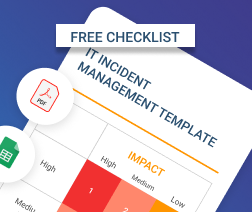In a modern-day organization, there are dozens of routine IT operations. Each simple service request or raised ticket requires you or your team members to perform a number of simple, yet mundane, actions to get it resolved. And when there are dozens of raised tickets or service requests a day, each day throughout a year, it's easy to get lost in the process. This is why the concept of IT process automation has become popular. It allows you to reduce the number of manual operations by automating some of the workflows, leaving less room for human error.
Read on to learn how to improve the efficiency of the IT processes in your department or MSP.
Definition of IT Process Automation
This concept implies a set of procedures and software solutions aimed towards creating a structured and straightforward workflow for IT tasks and operations. It helps us to create a unified infrastructure in complex IT environments with a large number of interconnected processes.
Which Processes Do You Automate?
As with many other IT management concepts, the definition and the idea behind ITPA is quite vague. So, to narrow this definition down, let’s define the concept of a process in ITPA and discuss what exactly you should automate.
Each process has some input information, the resources you need in order to resolve it, the people who will manage and review it, and the resulting output. Typically, you can break down a complex process into several subprocesses for better control and visibility. This is where IT process automation comes in.
There are tools that allow you not only to automate the processes themselves, but also to automate the management of the subprocesses and their movement. ITPA focuses on the connection between processes, assignment, and process review.
For example, when you install a new desktop for an employee, you need to buy some hardware and assemble it, restore the master image to it, create the accounts needed by the employee and install some custom software. All these processes can be automated by themselves. But you should also automate the workflow between these processes. That's the general idea of this concept.
Further reading The Benefits of Professional Services Automation (PSA) Solutions For MSPs
Typical IT Process Automation Areas
Let's define several of the most popular areas in an IT department or for a managed IT provider:
- Triage and escalation. First and foremost, the work of modern-day IT departments and MSPs is founded on working with tickets. These tickets have different difficulty levels, different topics, and different urgency. So, they should be managed and assigned differently. If your support team is managing triage and escalation manually, tickets that come in dozens per day can be forgotten, lost, or postponed without any obvious reason. So, you should leverage the full potential of your ticketing system. Most modern systems allow you to develop a flexible and automated procedure for canned responses, ticket assignments, and client and support team notifications. You will also be able to gather automated reports about solved and stuck tickets.
- Service or change requests. Your work with the tickets is the tip of the iceberg. The actual work that lies behind it is the service provided to the organization, and change management. Such requests can be assigned to one of your team members automatically and standard automated subtasks with checklists created. Once the task is finished, the team leader will be notified about it.
- Asset management. Your equipment and licenses are always on the move and you should track that movement. Licenses expire, hardware gets old and needs to be scrapped, and you constantly need to install new software and onboard new employees or move hardware to different departments. Asset tracking and management can and should be automated starting from day 1 of the organization. For sure, for a small team, some manual procedures may be fine. But as soon as you reach tens of devices, you will be better off with an automated solution. That will reduce your expenses on unused and misused IT assets.
ITPA Drawbacks
Implementing ITPA solutions and workflows requires both experience and time. It should be thought through and tested for the organization in question. Remember, there is no IT process structure and framework that fits all situations.
Here are some drawbacks of an incorrectly implemented ITPA:
- Overprocessed workflows. At the heart of ITPA is the idea of a breaking-down of processes into smaller parts. That might lead to an overengineered environment where you and your team do nothing but manage dozens of processes.
- Needs maintenance. IT process automation is not a set-it-and-forget-it solution. Processes and workflows constantly evolve and you need to change your workflows and approaches accordingly.
- Reliance on software solutions. The other danger of ITPA is that you typically rely on yet another software solution to support your new workflows. And that solution also needs to be managed and maintained. If it's down, your whole operation might go down as well.
Implementing IT Process Automation in the Organization
If you don't know where to start, here is a step-by-step guide:
- Perform an IT infrastructure audit. First of all, you need to break down your IT operations into processes in order to then define which parts can be automated.
- Group operations. This will help you to create standardized workflows for standard operations.
- Design the assignment process. Next, you should develop a formal structure for the movements between operations. Who will be notified and assigned to the ticket? Which tags and triggers will be appropriate for a given process?
- Check your design with your team. Sometimes, your team members know your operations much better than you. To not overengineer things; check your new workflows with your team, delete all the unnecessary parts and add what's missing.
- Create documentation. You need to create clear documentation for your team in order to acquaint them with the new approaches and workflows.
- Educate your team. In time, ITPA will become second nature but, during the first weeks or even months, your team may have issues with the new framework.
- Review processes regularly. As we've already said, the processes in modern IT are constantly changing. Your workflows should change as well. Schedule regular processes audit to identify whether your ITPA frameworks need to be changed.
Conclusion
In the year 2023, everything relies on IT at least to some extent. The systems, their architecture, the solutions and the processes built to support all that become interconnected and complex. The number of processes is vast, and the number of actions you need to perform in order to support these processes is similarly huge. Hence, as an IT professional, you need to have a constant awareness of IT process automation.







